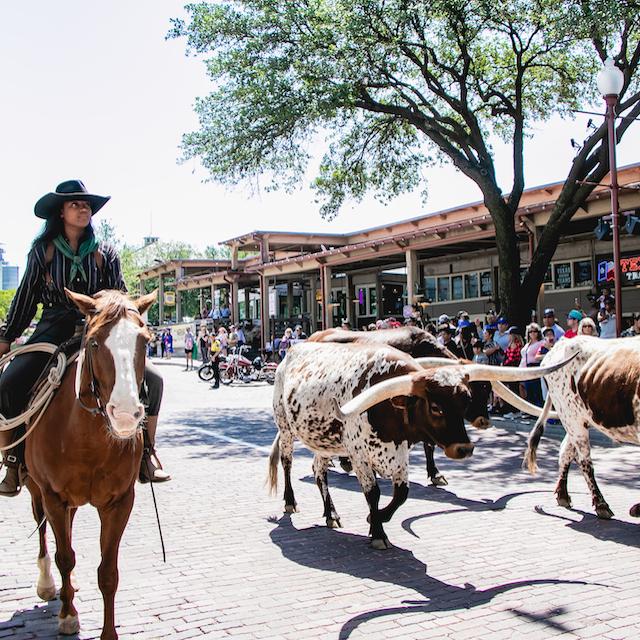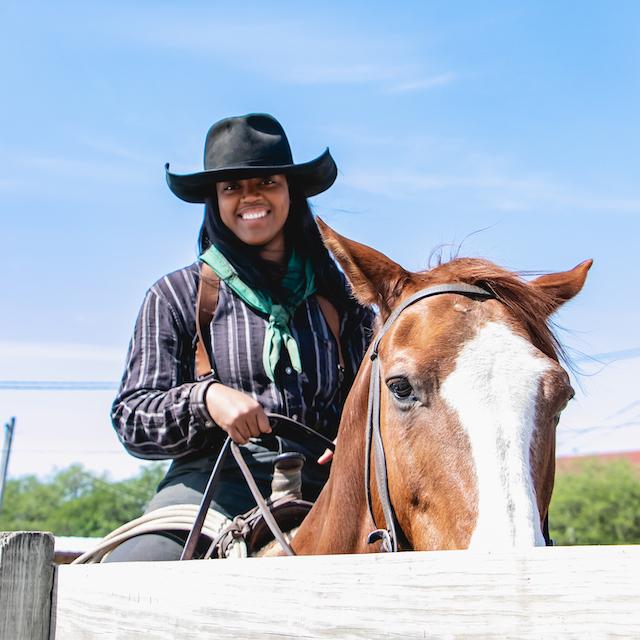
Saddle Up! Student Was First Black Female Drover in Fort Worth
Quinceola Reid is a TCU senior. She is a biology major with a minor in Spanish for health professions. She is a U.S. Navy veteran. And she was recently a drover for the Fort Worth Herd. Reid shared part of her diverse experience with TCU News.
What is the Fort Worth Herd, what was your role, and how did you become involved?
The Fort Worth Herd is the wonderful organization behind the twice daily (rain or shine!) longhorn cattle drive down East Exchange Avenue in the historic district of the Fort Worth Stockyards. They aim to keep the spirit of the late 1800s alive by dressing in period-accurate attire and utilizing period-correct saddlery and gear to provide visitors a glimpse into the past. The late 1800s were Fort Worth’s cattle industry heyday, when the Stockyards moved more money than Wall Street and catapulted Fort Worth into the thriving city it is today. In 2022, I was a drover, part of the team of individuals who conduct the cattle drive reenactments, tend to the longhorns and horses, and interact with out-of-town visitors.
What does a drover do, and how did you come to  participate?
participate?
A drover is someone who herds or drives livestock such as cattle. This term of driving doesn’t mean by vehicle but rather on horseback, one of the quickest ways to move large numbers of rather large animals across land. For the Fort Worth Herd, the drovers focus on many of the same things drovers did back in the late 1800s. I first saw the cattle drive myself when I visited the Stockyards with a group of friends. As an avid equestrian, the drovers on horseback caught my eye, and I began to wonder how they got such a sweet gig. After doing some research and asking around, I connected with a current drover who encouraged me to apply. It was actually a very normal interview process up until I was asked to demonstrate my riding ability on one of their horses (Bose, such a gentleman!), and the rest was history.
What is your field of study and how did this experience contribute to your education at TCU and preparing you for your future?
Working as a drover was a unique opportunity to connect what I had been learning in my biology courses about mammals to real-world applications. Concepts pertaining to their dietary requirements, social nature and environmental requirements helped me understand and improve my animal husbandry skills. Being a good stockman or horseman takes a whole lot of knowledge that I was grateful to learn from the other drovers, but understanding the “why’’ really reinforced the importance of our daily tasks and how it all interrelates.
Was there anything in your TCU education that you found yourself drawing on as a drover?
Absolutely. A lot of our Fort Worth locals and out-of-town visitors speak Spanish and being able to connect my minor studies to in-person interactions was really fulfilling. I am not fluent by any means, but everyone I spoke with was really encouraging and open to talking as much as we could manage. Then, my background in biology helped me monitor the health of the livestock and answer visitors’ questions about them.
We understand you were the first Black woman drover for the Fort Worth Herd. Can you share about that experience and why it is significant to you?
When I first took the job, I wasn’t aware that there hadn’t been a Black woman in the position until talking with my coworkers. As a veteran, I’m familiar with working in male-dominated spaces, and this job was very similar in that sense. However, the director of the Fort Worth Herd is a woman who has been in the position for quite some time, so it was great getting to see how she managed her role and led the team. What I found particularly significant is being able to achieve that critical representation. There are many fields of interest that have limited minority representation, which can seem to perpetuate for a long time until one day someone comes along and is a ‘’first.’’ In my own experience, something as simple as seeing someone you can relate to doing something you think is cool can be emboldening. I was honored at the number of times I was out riding on Exchange Avenue and would be stopped by people and given words of encouragement. Among those voices were people who echoed how important representation for minorities is or how great it was to see someone that “looks like them,” particularly young people. I’m thrilled to experience a job that not only fed into my passion for horses but connected me to the Fort Worth community.
In addition to the first Black female drover, how was it working in a male-dominated field? And one where you may have been younger than most?
Working in a male-dominated workplace can be tricky at times, and an age gap may further widen the disconnect. Being in the minority can attract attention of all kinds, like encouragement, dissuasion or indifference. Each circumstance is going to have its own challenges, but being decisive, prepared and flexible is my greatest advice when it comes to navigating through this. Knowing why you’re pursuing something, doing your research on what you’re getting yourself into, and being flexible enough to act when something isn’t a good fit for you are essential. It can take guts to step out of your comfort zone and into an opportunity, but knowing when to pivot and adjust your plan is such an important permission to give yourself. There is always more than one way to lasso a longhorn.
What was your favorite part about your time as a drover?
There was seriously a lot to love about being a drover. Hands down, one of my favorite things was the animals. I’ve loved horses my whole life, so getting to spend time giving them attention didn’t feel like a job at all. However, what I wasn’t expecting was to be so fond of those longhorns! I now see pictures of them all around town, from dental offices to billboards, and I can still name just about every one of them. They each have a unique personality and way about them. Cattle are hierarchical in nature, so if you think about what that usually implies socially, it can give you an idea of how intricate their interactions with each other and people can be.
Anything else that might be interesting to our Horned Frog audience?
I think a fun fact is that the Wild West was a lot more diverse than mainstream media tends to portray. Cowboy culture actually originated from the techniques and culture of Mexican vaqueros. Words like lariat, reata and chaps are all commonly used in American cowboy culture but are Spanish in origin. The cattle that made Fort Worth’s cattle industry what it is today came from down south near/in modern-day Mexico. So, not surprisingly, it was from the vaqueros that Americans learned to cowboy their livestock. African Americans frequently made up to 25% of the drovers responsible for herding cattle over 600 miles from Texas up to the railheads in Kansas. They were typically freed men who had previously worked cattle while enslaved. They had the experience and skills that were in high demand, and droving gave them the opportunity to earn money outside of the limited jobs they were permitted to have. In fact, many people of different but meager circumstances took this dangerous job as an opportunity to make decent money. European immigrants, Indigenous Peoples, vaqueros and boys as young as 14 frequently populated these teams. While it was predominantly men saddling up, there are even reports of women concealing their gender and taking to the trail. As you can see, there are a whole lot of stories worth hearing intertwined in the interesting history of post-Civil War Fort Worth.
